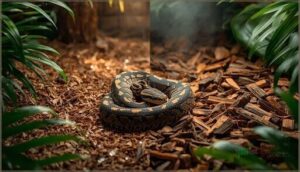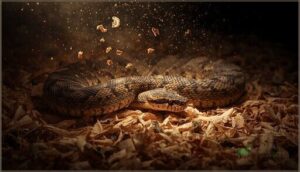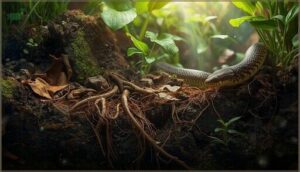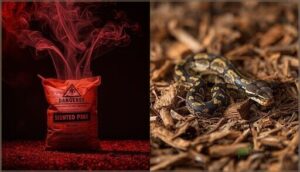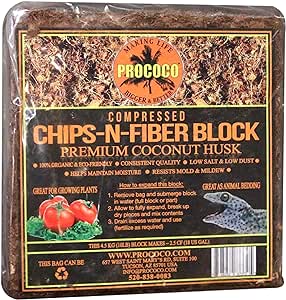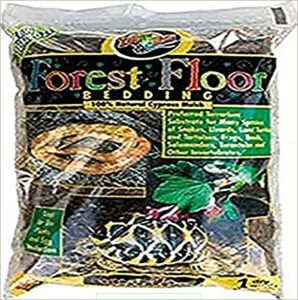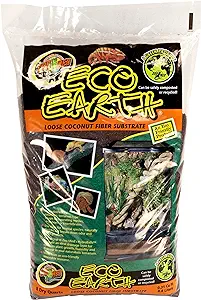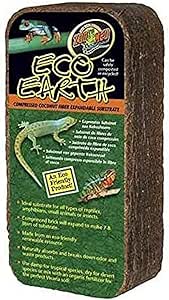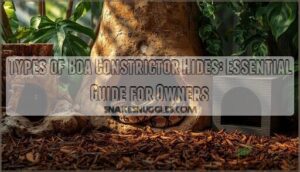This site is supported by our readers. We may earn a commission, at no cost to you, if you purchase through links.
Your boa constrictor spends nearly every moment in direct contact with one thing: the substrate lining its enclosure. That seemingly simple layer of material directly affects your snake’s respiratory health, digestion, stress levels, and overall well-being.
Yet many boa owners grab whatever looks natural at the pet store without considering whether it holds humidity properly, harbors dangerous molds, or poses an impaction risk.
Choosing a boa constrictor substrate isn’t about aesthetics—it’s about creating an environment where your snake can thermoregulate, breathe easily, and behave naturally. The wrong choice can lead to respiratory infections, bacterial growth, or even life-threatening blockages.
Understanding what makes a substrate safe and effective will help you avoid these pitfalls and give your boa the foundation it needs to thrive.
Table Of Contents
Key Takeaways
- Your boa’s substrate directly impacts respiratory health, digestion, and stress levels—choose materials that hold 60-70% humidity, absorb waste effectively, and avoid toxic compounds like phenols found in pine and cedar.
- Coconut fiber and cypress mulch consistently outperform other options by balancing moisture retention with mold resistance, while aspen shavings fail in high-humidity setups and wood chips pose ingestion risks.
- Daily spot-cleaning prevents ammonia buildup within 24-48 hours, while full substrate replacement every 3-6 months (or monthly deep-cleans for bioactive setups) stops bacterial and mold growth before it threatens your snake.
- Fine-textured substrates reduce burrowing effort by up to 350% compared to coarse materials, letting your boa exhibit natural behaviors while maintaining the thermal gradients it needs to thermoregulate properly.
Key Factors in Choosing Boa Substrate
Picking the right substrate for your boa constrictor isn’t just about throwing some bedding in the enclosure and calling it a day. The substrate you choose directly impacts your snake’s health, comfort, and how much time you’ll spend maintaining the habitat.
Let’s look at the key factors you need to think about before making your decision.
Humidity Retention and Control
For boa constrictor substrates, humidity control isn’t just about moisture retention—it’s about creating the right microclimate. Your substrate choice directly impacts humidity levels, which should stay between 55-75% (bumping to 85% during shedding). Coconut fiber and cypress mulch act like natural sponges, holding moisture while allowing airflow.
Pair them with misting techniques, water features on the warm end, and proper substrate depth. Monitor humidity levels with a digital hygrometer, and balance ventilation to prevent sogginess without losing essential moisture.
Absorption of waste is an important factor when choosing a substrate.
Absorption and Odor Management
Absorption and Odor Management directly affect how often you’ll clean your boa’s enclosure. Fresh waste converts to ammonia within 24–48 hours in warm tanks, so substrates with strong absorption capacity—like coconut fiber—slow odor buildup through effective Moisture Retention and Waste Breakdown.
Microbial Activity in absorbent bedding breaks down urine and feces, controlling Ammonia Buildup. Using eco-friendly coconut bedding can be safely composted or recycled.
Pair good absorption with daily spot cleaning for superior Odor Control and hygiene.
Safety—Non-toxic and Allergen-Free Materials
Strong absorption means nothing if your substrate poisons your snake. Softwoods like pine and cedar emit phenols that can damage boa livers and kidneys, while dusty materials increase dust inhalation and respiratory health problems. Watch for mold growth in damp bedding—it fuels mite infestations and chemical sensitivities in sensitive snakes.
- Skip aromatic wood shavings; Phenol Toxicity outweighs any odor benefits
- Choose low-dust, unscented safe materials to protect respiratory health
- Inspect for mold weekly; organic substrates carry ingestion hazards and impaction risk when contaminated
Comfort, Burrowing, and Movement
Your boa moves constantly, checking hideouts and testing corners. Fine particles like coconut fiber lower locomotion costs by up to 350% compared with coarse chips, making burrowing effort easier and your snake more confident. Substrate texture shapes hiding behavior—smooth, moldable bedding lets boas wedge and dig naturally. Pair adequate enclosure space (4’×2′ minimum) with 3–4 inches of fine substrate choice to support natural habitat comfort factors and reduce stress.
Fine substrate like coconut fiber cuts a boa’s burrowing effort by 350%, building confidence through natural digging and hiding
| Substrate Type | Burrowing Ease |
|---|---|
| Fine coconut fiber | Excellent |
| Cypress mulch | Good |
| Aspen shavings | Fair |
| Coarse wood chips | Poor |
| Bioactive mix | Excellent |
Substrate Depth and Enclosure Fit
When matching substrate to your boa’s habitat, depth matters just as much as type. A 4’×2′ enclosure requires roughly 80 quarts at four inches deep—enough for meaningful burrowing opportunities without blocking access doors.
Depth benefits include stable humidity and natural digging behavior, but remember: deeper substrate adds weight. Calculate volume before filling to balance enrichment with practical access and enclosure size limits.
Comparing Popular Substrate Types
Now that you know what to look for, let’s compare the most common substrate options side by side.
Each type has its own strengths and weaknesses regarding humidity retention, safety, and maintenance. Understanding these differences will help you choose the best match for your boa’s needs.
Coconut Fiber Vs. Cypress Mulch
When comparing substrate choices for boa constrictors, both coconut fiber and cypress mulch excel at humidity control, keeping levels around 60–70% with regular misting. Coconut fiber generally offers better odor control and mold resistance, while cypress mulch’s softer texture makes burrowing easier.
Both carry minimal impaction risks when used properly, though cypress can compact over time, reducing airflow and requiring occasional turning.
Aspen Shavings and Wood Chips—Risks and Drawbacks
Although aspen shavings are popular for some reptiles, they can cause problems for boa constrictors. Their low humidity retention often leads to incomplete sheds, while dusty particles trigger respiratory irritation in your snake’s sensitive airways.
Impaction hazards increase when boas ingest chips during feeding, and mold growth develops quickly in damp spots.
Pine/cedar products pose additional allergenic exposure risks through volatile compounds that damage lung tissue.
Bioactive Substrates—Pros and Cons
A bioactive approach transforms your boa’s enclosure into a living ecosystem, but it’s not for everyone. Here’s what you need to weigh:
- Ecosystem Establishment takes 4-6 weeks before introducing your snake
- Waste Breakdown by detritivore insects and cleanup crew reduces odors within 24 hours
- Invertebrate Risks include potential parasite reinfection if your boa eats contaminated bugs
- Behavioral Enrichment encourages natural burrowing and exploring behaviors
- Long-Term Costs are higher initially but reduce replacement frequency to multi-year intervals
Bioactive substrate benefits include self-sustaining moisture cycles and minimal full cleanouts, though bioactive substrate setup demands careful monitoring.
Avoiding Scented or Chemically Treated Substrates
Scented products are a red flag—your boa doesn’t need “fresh-scented” substrate filling its airspace with volatile organic compounds. Pine and cedar products release aromatic oils that trigger respiratory irritation and chemical toxicity in reptiles.
Always practice label scrutiny: choose plain, untreated coconut fiber or cypress mulch marketed specifically for reptiles. DIY substrates work well when you verify each component is fragrance-free and chemical-free.
Top 8 Substrates for Boa Constrictors
Now that you understand what makes a good substrate, let’s look at some specific products that work well for boa constrictors.
Each option below has been chosen for its ability to maintain humidity, absorb waste, and keep your snake safe and comfortable.
You’ll find a mix of coconut-based and other natural materials that meet the key requirements we’ve discussed.
1. Zoo Med Aspen Snake Bedding
Zoo Med Aspen Snake Bedding is a widely used reptile substrate that brings solid absorbency and low dust to the table. With a 191% absorbency rating, it allows for spot cleaning well and helps with odor management between full changes. You’ll appreciate that it’s 99.9% dust free, which promotes respiratory safety for your boa.
The shavings allow comfortable burrowing and movement, though aspen shavings work best in moderate humidity setups—mold prevention requires careful moisture control. Replace bedding every 2–3 months to maintain a clean, healthy environment for your snake.
Best For: Boa constrictor owners who want a natural, low-dust bedding that supports burrowing behavior and works well in moderate humidity enclosures with proper moisture management.
- High absorbency rating (191%) makes spot cleaning easy and helps control odor between full bedding changes
- 99.9% dust free and contains no toxic oils, reducing respiratory irritation risk for your snake
- Allows natural burrowing and nesting behavior while maintaining a clean, comfortable substrate surface
- Not ideal for high-humidity setups—can develop mold if kept too wet or misted frequently
- Requires full replacement every 2–3 months and careful feeding practices to avoid accidental ingestion
- May be dusty when first poured and doesn’t retain ambient humidity as well as alternatives like cypress or coconut fiber
2. ReptiChip Coconut Chip Reptile Substrate
ReptiChip Coconut Chip Reptile Substrate offers excellent humidity retention and odor control for your boa. This organic material expands from a 10-pound compressed brick to 72 quarts of substrate—enough to cover multiple enclosures.
The triple-washed coconut fiber arrives free from parasites and dust, reducing respiratory risks. You’ll find it holds moisture without becoming waterlogged, creating ideal conditions for shedding.
At $34.95, it provides excellent expansion volume and can be spot cleaned easily. The soft texture fosters natural burrowing behavior while maintaining the 60-70% humidity levels your boa needs.
Best For: Boa owners looking for an organic, high-capacity substrate that maintains humidity well and expands to cover multiple enclosures affordably.
- Expands to 72 quarts from a compact 10-pound brick, offering great value and enough substrate for several setups
- Triple-washed and parasite-free right out of the package, so no prep work like baking or freezing needed
- Holds moisture without getting soggy, helping your boa shed properly while controlling odors naturally
- Higher upfront cost at $34.95 compared to simpler substrate options like newspaper or paper towels
- Can kick up dust when you’re expanding it with water, so you’ll want to handle it carefully
- Not ideal if your boa loves deep burrowing, since the chip texture doesn’t pack down like finer substrates
3. Natural Coconut Husk Reptile Bedding
Natural Coconut Husk Reptile Bedding gives you all the moisture retention benefits of coconut fiber in a loose, ready-to-use format. This 21-quart bag of organic coir absorbs over four times its weight in liquid, keeping your boa’s enclosure fresh through excellent odor elimination.
The coarse texture provides comfortable burrowing while maintaining natural habitat conditions. You won’t need chemical treatments—the material’s naturally resistant to mold and holds humidity effectively. At around 3-4 inches deep, it fits standard enclosures perfectly and encourages your snake’s instinctual behaviors without respiratory concerns.
Best For: Snake owners who want a natural, moisture-holding substrate that supports humidity control and reduces odors without constant replacements.
- Absorbs over four times its weight in liquid and holds humidity naturally, perfect for tropical snakes like boas that need consistent moisture for healthy shedding.
- Made from 100% organic coconut fiber with no chemicals or added scents, so it’s safe if your snake accidentally ingests small amounts during feeding.
- Encourages natural burrowing and thermoregulation behaviors while staying mold-resistant and allowing easy spot-cleaning between full changes.
- Can be dusty out of the bag, which might irritate respiratory systems in sensitive pets or people during initial setup.
- More expensive per quart than basic paper or aspen options, and larger bulk sizes aren’t always available.
- Needs occasional misting to maintain optimal humidity levels, so it’s not completely hands-off like some low-maintenance substrates.
4. Coconut Husk Growing Media Chips
When you need substrate volume on a budget, coconut husk growing media chips deliver. This BVYY product expands from 4.5 kg into roughly 75 quarts—enough for multiple enclosure changes.
The chip texture stays loose and aerates well, with pH levels around 5.5-6.5 that won’t irritate your boa’s skin. Moisture retention hits that sweet spot for humidity levels between 60-70%, though you’ll want to let the material dry slightly after expansion.
It’s a sustainable choice that meets boa constrictor substrate needs without breaking the bank.
Best For: Boa keepers on a budget who need a high-volume, moisture-retentive substrate that supports proper humidity without frequent replacement.
- Expands to 75 quarts from a compact block, giving you enough material for several full substrate changes at a lower cost per use
- Holds humidity well in the 60-70% range that boas need, while the coarse chip texture resists compaction and keeps airflow moving through the bedding
- Natural and sustainable coconut by-product with a neutral pH that won’t irritate your snake’s skin, plus it’s low-dust and easier to spot-clean than finer substrates
- Often arrives quite damp after expansion, so you’ll need to spread it out and let it dry before storing any excess
- Some users report inconsistent moisture retention, with water sometimes draining through too quickly depending on the batch
- Carries a potential impaction risk if your boa strikes prey on the substrate and swallows chips, especially with younger snakes
5. Natural Forest Floor Bedding Material
Looking for a substrate that mimics your boa’s natural habitat? Cypress mulch bedding creates that forest floor look with dead leaves and organic texture your snake recognizes.
Zoo Med’s 24-quart option holds humidity between 60-70% when you layer it 2-4 inches deep—perfect during shed cycles. The chunky texture encourages burrowing behavior while staying loose enough for easy movement.
Just watch for biosecurity risks: spot-clean daily and replace everything every 3-4 months to prevent mold in those moisture-rich conditions. It’s a solid middle ground between bioactive complexity and simple substrate materials.
Best For: Boa owners who want a naturalistic setup that holds humidity well and supports burrowing behavior, and who are willing to do regular spot cleaning and full substrate changes every few months.
- Maintains 60-70% humidity when layered 2-4 inches deep, which is ideal for boas especially during shedding
- Encourages natural digging and burrowing behaviors while providing a stable walking surface
- Lasts 3-4 months before needing a complete change, making it longer-lasting than paper-based options
- Makes it harder to spot waste and requires daily spot cleaning to stay on top of hygiene
- Can support mold growth if humidity isn’t balanced properly or if cleaning is neglected
- Often arrives dusty and may need rinsing before first use to reduce particulates
6. Coconut Fiber Reptile Substrate Mix
Zoo Med’s coconut fiber substrate holds moisture up to nine times its weight, keeping humidity levels right where your boa constrictors need them—between 60 and 80%. Burrowing comfort improves dramatically compared to paper towels, and the odor absorption rate beats most wood-based options.
Market demand trends show this substrate’s growing popularity for good reason: it’s compostable, dust-free, and promotes natural thermoregulation.
Spot-clean soiled areas twice weekly and replace the full layer every few months to prevent mold in high-moisture setups.
Best For: Snake keepers who want a natural, moisture-retaining substrate that supports burrowing behavior and maintains the 60–80% humidity tropical species like boa constrictors need.
- Holds up to nine times its weight in water, making it easier to keep humidity stable without constant misting.
- Absorbs odors and waste effectively when spot-cleaned regularly, reducing ammonia buildup compared to non-absorbent surfaces.
- Eco-friendly and compostable, with a soft texture that lets snakes burrow and thermoregulate naturally.
- Can stick to prey during feeding time, which some keepers find annoying.
- Dries out quickly in low-humidity rooms, so you’ll need to mist or rehydrate it to keep odor control working.
- Requires spot cleaning multiple times a week and full replacement every few months to prevent mold in high-moisture setups.
7. Eco Friendly Coconut Fiber Substrate
Compressed coconut fiber blocks expand up to seven times their volume when you add water, giving you plenty of ecofriendly bedding for less waste. Coir pH stays neutral enough to support beneficial microorganisms that help with waste breakdown, and the fine texture provides excellent burrowing support for your boa.
You’ll need to watch moisture balance carefully—overly wet substrate can spike humidity levels past your snake’s comfort zone. Mixing in drier material helps maintain the 60–70% range.
Since coconut fiber comes from agricultural by-products, sourcing impacts remain lower than peat-based alternatives.
Best For: Boa owners who want a renewable, high-absorbency substrate that supports natural burrowing behavior and helps maintain tropical humidity levels when properly hydrated.
- Expands up to seven times in volume from a compressed brick, giving you a lot of bedding from minimal packaging while reducing waste compared to single-use alternatives.
- Neutral pH supports beneficial microbes that break down waste and control odors, making spot-cleaning easier between full substrate changes.
- Sourced from coconut husk by-products rather than slow-forming peat deposits, so your environmental footprint stays lower with every bag you buy.
- Holds moisture so well that fully hydrated fiber can push humidity above 70%, requiring you to mix in drier material or adjust ventilation for many boa setups.
- Not ideal as a standalone base in large bioactive enclosures—you’ll need to blend it with topsoil or sand to give adult boas the structural support they need for burrowing.
- Oversaturation during prep invites localized mold growth, so you’ll need to mist lightly and monitor moisture levels instead of soaking the entire brick at once.
8. Organic Coco Coir Garden Soil
Though marketed for plant care, organic coco coir garden soil works well as a boa constrictor substrate when you verify it’s free from added fertilizers. Its moisture retention keeps humidity levels stable between 60–70%, and natural fibers provide odor neutralization by trapping waste liquids effectively.
You’ll appreciate how the soft texture promotes safe burrowing without compaction. Since it expands considerably when hydrated, one block covers most standard enclosures.
Just confirm the product contains pure coconut fiber—no chemical additives—before introducing it to your setup for best boa comfort and enclosure integration.
Best For: Boa owners who want an eco-friendly substrate that holds humidity well and supports natural burrowing behavior without breaking the bank.
- Retains moisture like a champ—keeps humidity steady at 60–70% so you’re not constantly misting the enclosure.
- Soft and safe for burrowing, plus it naturally controls odors by trapping waste liquids and cutting down ammonia buildup.
- One compressed block expands to cover most standard enclosures, making it cost-effective at around $0.05 per square foot.
- You need to check labels carefully since some garden versions sneak in fertilizers or additives that aren’t safe for reptiles.
- Requires a big container for hydration and might need buffering to remove fine particles that could cause issues.
- Doesn’t come with nutrients, so if you’re mixing it into a bioactive setup, you’ll need to add other soil components for live plants.
Substrate Maintenance and Cleaning Tips
Keeping your boa’s substrate clean isn’t just about appearances—it directly impacts their health and comfort. You’ll need a consistent maintenance routine that balances thorough cleaning with preserving the right humidity levels.
Let’s break down the practical steps for keeping your enclosure fresh and your snake thriving.
Recommended Cleaning Frequency
Your boa’s health depends on a consistent substrate cleaning rhythm. Daily spot-cleaning removes feces and urates within 24 hours to stop bacteria buildup and ammonia accumulation. Here’s a practical cleaning frequency guide:
- Daily Spot-Cleaning: Remove waste and refresh water bowls every 1–2 days to prevent odor indicators like bacterial film.
- Monthly Deep-Cleans: Replace all substrate and disinfect surfaces, hides, and décor to eliminate pathogens.
- Bioactive Schedules: Spot-clean waste immediately but refresh only top layers every 1–3 months—full teardowns happen only when mold or persistent odor appears.
Cleaning factors like humidity levels and feeding frequency affect waste management needs.
Spot Cleaning Vs. Full Replacement
Your substrate maintenance strategy depends on your cleaning method. Spot cleaning addresses daily waste buildup and improves pathogen control without disrupting your boa’s environment—think of it as stress reduction through consistency. Full replacement resets everything every 3–4 months for traditional setups, while bioactive benefits include years-long substrate life.
Here’s how substrate choice affects your cleaning frequency:
| Method | When to Use |
|---|---|
| Spot Cleaning | Daily waste management—remove feces, urates, and contaminated material within an 8–10 inch radius |
| Full Replacement | Every 3–6 months for coconut fiber or cypress mulch; monthly for paper substrates |
| Bioactive Maintenance | Continuous spot removal; full change only if mold or persistent odor appears |
Maintaining Proper Humidity During Cleaning
Cleaning disrupts moisture levels faster than most keepers realize—but you can control the bounce-back. Your hygrometer placement at mid-height lets you track real-time humidity drops and confirm when levels return to the 60–70% target range.
Use these misting techniques to restore balance:
- Refill and position your water bowl on the warm side for faster evaporation
- Mist substrate evenly, not in puddles, mimicking natural moisture distribution
- Add humid hides with moistened moss during shedding periods up to 70–85%
- Adjust ventilation effects by partially covering screen tops after wet cleaning
Monitor humidity requirements for boas throughout the day—levels shouldn’t stay below 55% for hours after you finish.
Substrate Safety Concerns and Health Risks
Even the best substrate can pose hidden risks if you’re not careful. From ingestion hazards that lead to serious blockages to respiratory troubles caused by dust and mold, these concerns deserve your full attention.
Let’s walk through the main health risks you need to watch for and how to keep your boa safe.
Ingestion and Impaction Risks
When your boa accidentally consumes particles during feeding, impaction becomes a real concern—especially if hydration and digestive tract health aren’t ideal. Substrate safety considerations like particle size matter: smaller pieces reduce blockage risk by 80%.
Watch for impaction symptoms such as lethargy or constipation. Ingestion prevention starts with proper feeding methods and choosing safer substrate options for boa constrictors, each with distinct pros and cons affecting dietary impact and overall health.
Allergic Reactions and Respiratory Issues
Your boa’s breathing comfort can suffer from dust allergies and VOC exposure. Cedar releases compounds that trigger respiratory infections in up to 24% of exposed animals.
Aspen shavings produce fewer irritants than Pinecedar products, but watch for substrate irritants like fine coconut dust.
Mold growth in damp bedding worsens respiratory problems in boas, causing the “huffing” you might notice during routine cleaning.
Preventing Mold, Mites, and Bacteria
Beyond respiratory concerns, poor hygiene invites serious problems—mold, mites, and bacteria thrive when moisture levels stay too high or ventilation suffers. Protect your boa with these Hygiene Practices:
- Spot-clean waste daily to limit bacteria growth
- Replace substrate every 3–6 months
- Use cross-ventilation to prevent mold
- Dry surfaces between mistings
- Switch to paper during mite outbreaks
Proper substrate maintenance keeps fungi and parasites at bay.
Frequently Asked Questions (FAQs)
Can I mix different substrate types together?
Yes, you can blend substrate types to balance moisture retention and drainage. Many keepers use DIY mix ratios—like combining coconut fiber, topsoil, and sand—for improved bioactive approach performance and safer, more natural layering substrates that support burrowing.
How much does quality substrate typically cost?
Quality substrate for your boa constrictor generally runs $15–$25 per full change for standard enclosures, while bioactive setups cost $150–$200 initially.
Annual spend estimates average $75–$150, depending on enclosure size and substrate types you choose.
What substrate works best for baby boas?
For juvenile boas, coconut fiber works wonderfully—maintaining 60-70% humidity levels while minimizing impaction risks.
Provide at least 2-inch substrate depth, enabling burrowing behaviors that support shedding success in safe substrates.
Do substrates affect a boas feeding behavior?
Substrate choice directly influences feeding behavior in boa constrictors. Ingestion risk increases when prey contacts loose bedding, while proper humidity and scent cues support consistent feeding.
Using feeding boxes reduces impaction and stress for better snake health.
Where should I buy substrate for boas?
You’ll find boa constrictor substrates through online retailers, specialty chains like Petco, brand websites such as Zoo Med, and bioactive vendors.
Regional access varies, but e-commerce expands substrate options for enclosure setup and snake health.
Conclusion
Your boa won’t complain about a poor environment—it’ll simply stop thriving. Choosing a boa constrictor substrate that balances humidity, safety, and comfort puts you in control of your snake’s health before problems emerge.
You’ve seen the options, understood the risks, and learned what separates a suitable bedding from a dangerous one. Now you can make a confident decision that keeps your boa breathing easy, moving naturally, and living well for years to come.
- https://reptifiles.com/boa-constrictor-care/boa-constrictor-substrate/
- https://dubiaroaches.com/blogs/how-to-guides/how-to-set-up-a-boa-constrictor-terrarium
- https://www.thebiodude.com/blogs/snake-caresheets/boa-constrictor-care-guide-and-bioactive-terrarium-maintenance
- https://www.knobcreeknaturalist.com/blog/boa-constrictor-temperature-and-humidity-requirements
- https://www.reptco.co.uk/images/files/Boa%20Constrictor%20Care%20Sheet.pdf


